Genre: Platformer Developer: Paws Publisher: Sega Enterprises Players: 1 Released: 1995
When I spotted a boxed copy of Garfield: Caught in the Act selling for about $6, I chose to buy it. After I brought the game home, I got out some old EGM magazines since I remembered them reviewing Garfield back in 1995. Reading their comments made me expect impressive graphics, but overly difficult and frustrating gameplay. As I tried the game for the first time, I could see where the reviewers were coming from, but I did not agree with their assessment, especially when I beat the game a few hours after my very first try. The game is far too short and easy, but it has enough quirky features and charm to keep retro gamers coming back for more.
The storyline is very simple but promising: as he watches TV one evening, Garfield is surprised by the sudden barking of his friend Odie and accidentally falls on the TV set, which is instantly broken. He tries to piece it back together, but as soon as the late-night broadcast begins, he is sucked into the TV and thrown in a variety of midnight-movie inspired settings. Level one is a Castlevania-like trip in haunted territory; level two takes place near the sea; level three in prehistoric times; level four in the busy streets and swamps of a city; level five in Egypt.
The game came out in late-1995 and makes judicious use of the Genesis’ capabilities. The characters, backgrounds and colors are all excellent. Every level has its own theme and atmosphere. For example, there is even a black-and-white stage, a la Mickey Mania. In the first level, a dark, vampire-themed stage, you spend time both on the ground and in beautifully rendered caves, as you walk on coffins and hang from tongues (!); the fifth, ‘Egyptian’ level also has its share of striking colors and effects.
Garfield himself seamlessly crosses over in this video game debut: he is well-sized, smoothly animated and has a vast set of moves at his disposition, from his various attacks to his unique gestures as he pushes blocks/rocks, looks around or simply stands still. The cartoon’s deadpan humor has been kept intact and shines throughout: Garfield adapts to the various settings with amusing touches – he wears a cape in the vampire-themed level, he has fangs in the prehistoric stage; he wears a hat in level four, etc.
The music is solid and fits in well with the stages’ contrasting environments. My favorite level visually and aurally is the first, Count Slobula: the organ-driven music is at once haunting, creepy and sarcastic. The sound effect heard when Garfield takes a hit is bizarre indeed… Surprisingly for such a game, there are no voice samples.
The play control might seem difficult at first, but it is coherent: after all, you play as a big, nonchalant cat! Repeated playing should familiarize you with Garfield’s peculiarities (how he reacts to stop-and-gos, his jumping abilities, etc.). All three buttons of the original Genesis controller are used: one for jumping, one for a close-range attack, and the other for throwing projectiles that are found in each stage. Admittedly, the close-range move is not always effective, especially against small flying enemies such as birds and bats; some sections also require precise timing and lead to many missed tries. But with some practice the moves are easy to pull off; besides, the slight difficulty of the controls does give the game some of the challenge it dearly lacks.
The game’s structure is odd and quite interesting, and the actual levels are only a part of the big picture. Before each stage, you have to navigate your way through the inside of a television, getting by wires, springs and bolts in order to reach your next program/stage. The final stage is, in fact, a boss encounter in this same environment. After completing a level, you get to play two kinds of bonus games, both of which can net you an extra life or continue.
These gifts are completely superfluous. As I have written earlier, I have beaten the game only a few hours after my very first try. The low difficulty level can be explained by many factors. The stages themselves are short, spanning few sub-sections. Even if you do suffer some mandatory hits in this game, Garfield must be hit a whopping ten times to lose a life. Checkpoints are numerous, and both health (in the form of hamburgers and pizza, of course…) and 1-ups are easy to come by. The password feature serves no real purpose because it is fun to get through the early levels, and their brevity enables repeated playthroughs. But this brevity is ultimately disappointing: the game starts very strong, and as you get by level five you are hungry for more… but have to settle for an all too early encounter with the final boss. Playing at the highest difficulty level does not up the challenge nearly enough; the only difference is that some items give you one projectile instead of two, and you are no longer shown which direction to take. The ending is exactly the same for both difficulty settings.
The game is so easy that I can beat it without using continues or passwords… and without losing a single life! This lack of challenge definitely hurts the game’s replay value, but I do enjoy beating it time and time again. The unique structure and characteristic mannerisms of Garfield keep me coming back, as do some of the bosses: especially the massive Pharaoh of the fifth level, which has to be attacked in four different ways, and the final boss, whose bolts you have to deflect while using angled mirrors.
Sega had the beginning of a great game, but unfortunately chose to release it without the sufficient number of levels. EGM’s contentions about the game’s excessive difficulty make me question their skills; and Sega should have spent more testing time to hone the game’s overall balance. Had I bought this cart in 1995 and paid the full price for it, I would certainly have been disappointed. But in this day and age, you can usually buy 16-bit games for eight to twenty times less than what they originally cost, Garfield: Caught in the Act thus becomes a worthy find.
SCORE: 6 out of 10

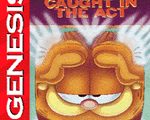
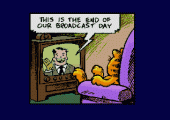
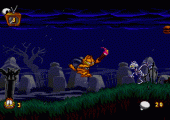
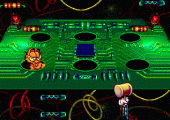
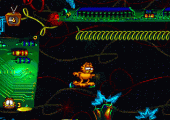
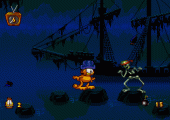
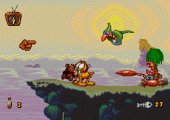
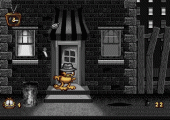
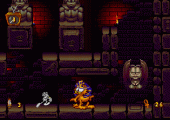
Recent Comments